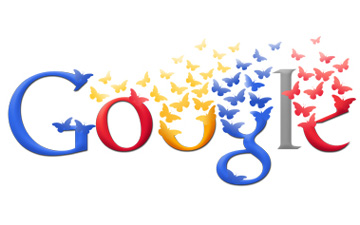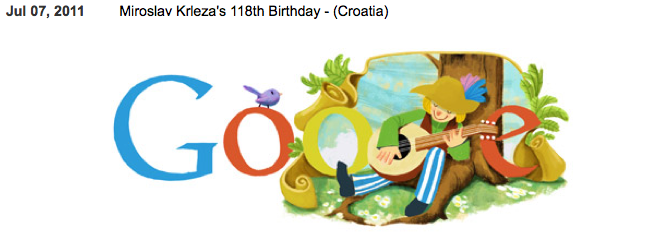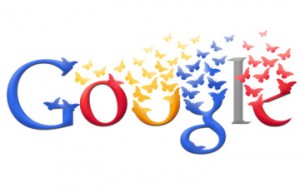Back when Google‘s logo still had an exclamation point, its founders Larry Page and Sergey Brin encountered a practical problem. On one hand, they had plans to attend the Burning Man Festival. On the other, they weren’t entirely confident that the site would not crash in their absence. And if it did, there wasn’t anyone at the office to answer the phone while the pair camped out in the desert.
The first Google Doodle — which showed Burning Man’s iconic stick figure popping out of the Google logo — was, in essence, an “out of office” message.

Throughout the next several years, Google started occasionally adding decorations to its logo for holidays like Thanksgiving and Halloween. Sergey Brin filed a patent for those decorations, which he called “systems and methods for enticing users to access a web site,” in 2000. It was granted in 2011.
“Google Doodles” are now an established part of Internet culture. We, Internet users, are delighted to find creative takes on holidays we forgot about, outraged when an event’s Doodle depiction seems off. We played the Google logo guitar so much that Google created a dedicated website for it.
For a long period of time, all Google Doodles were created by a former intern and current employee named Dennis Hwang. The process has since been taken to another level. Here’s what goes into the beloved (and at times bemoaned) Doodles.
The “Google Doodlers”

Jennifer Hom is part of a team of artists (officially “a handful” — more specifically, many fewer than 10), who coordinate and create Google’s Doodles. Their art backgrounds are diverse. One was a feature film animator, another illustrated comic books. Hom recently graduated from the Rhode Island School of Design.
Ideas come from the team, Google’s more than 28,000 employees, users and the news.
“It’s always a surprise,” Hom says. “And we try to pick things that are going to be exciting to our users, whether it was in their childhood or something they learned in school or important events or an important part of their culture.”
Production timelines vary greatly. While the team can theoretically plan for the Fourth of July Doodle all year, current events aren’t current for very long. When NASA found water on the moon in 2009, for instance, Hom’s pitch to Doodle it was accepted around lunchtime — giving her about four hours to conceive and create a Doodle.
Together, the team produced 271 Doodles last year.
Math Nerd Support
Most artists who want to create a guitar that records and plays back music, an image repelled by a cursor or a buckyball that spins when you roll with the mouse are out of luck. Google Doodlers have access to one of the largest pools of computer engineers on the planet.
While Hom says the Google Doodle team has never taken a Google engineer completely off of his or her full time job to work on a Google Doodle, at least one of them, search team software engineer Kris Hom (no relation to Jennifer Hom), regularly dedicates his 20% time to the cause. Some weeks, it ends up being 30%, 40% or 50% time.
When the buckyball design presented a mathematical challenge, for instance, he emailed other engineers on his team who promptly delivered a handful of successful solutions.

Having math nerds on hand also came in handy with the Pi Day Google Doodle, which was designed to look like a mathematician’s notes.
“For that, we had to consult our math experts that are floating around Google … and just make sure that every single curve and every single note that we put on the Doodle was accurate,” Jennifer Hom says.
International Offices

Google has more than 50 domains in 50 different countries, and it creates Doodles specific to many of them. But for a team based in the United States, it’s hard to remember that Miroslav Krleza’s 118th Birthday is being celebrated in Croatia.
Fortunately, Google’s many international domains come with many international offices. Their staffs contribute culturally appropriate Doodle ideas and check Doodles for cultural suitability before they go live.
Doodle Influence

By one 2009 study’s estimate, Google accounts for a whopping 6% of all Internet traffic. Directing the attention of many Internet users to a given topic, be it by Doodle or otherwise, is no little matter of influence.
“There’s always kind of a responsibility in terms of not offending anyone,” Hom says. “We don’t want to put anything too heavy as a Doodle, anything that’s not uplifting.”
Not offending anyone is a feat that’s hard to accomplish, particularly when experts from every niche are using your page as a web launching point. In 2003, an artist made a small error in the depiction of DNA on Google’s homepage. The reaction was powerful enough that Hom still talks about it today, even though the incident predates her Google Doodle debut.
“I’m really afraid of having a DNA moment,” she says.
Research keeps the math, science and history buffs happy, but sometimes the desire to not offend anyone can be self-defeating. Google’s Doodle for gay pride, a rainbow attached to the search bar, only appeared when a user searched for related terms — drawing criticism that the company had put its pride in the closet.
Why Doodle?
Google is not known for its artistic creativity. It’s known for making algorithms that work really well. So why hire a team to dress up the homepage, occasionally distract engineers and open the company to criticism of its portrayal of events?
“[Google does] a lot of awesome things in terms of technology,” Hom says. “But it’s easy for users to forget that we’re real people, too. So I guess that’s really the purpose of Doodles. … We make mistakes with DNA sometimes also, but we’re here to keep the fun in the company and make sure the users know that we’re alive.”

 Follow
Follow